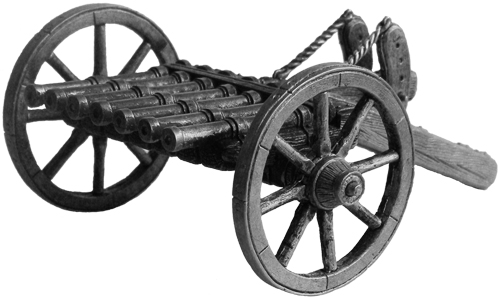Great War Organ Gun November 28, 2014
Author: Beach Combing | in : Contemporary , trackbackThe organ gun, also known as the ribadulequin, was one of those crude innovations in military technology that shifted humanity towards the ‘elegant’ killing of the machine gun arc. Organs were basically guns with many barrels and one trigger and were as liable to explode in the gunner’s face as to blast away the opposition. Beach recently stumbled upon one late use of the organ gun, or something very like it, from the First World War.
The trench warfare on the Western front has led to some rough-and-ready revivals of old methods. One of the illustrated papers [which?] recently published a photograph of what is practically an improvised revival of the organ gun. In a captured trench the French had taken a number of German Mausers and a quantity of ammunition. They fastened the rifles side by side in two rows, one above each other, on a wooden frame to a central working point, where they could be drawn tight by pulling a wooden lever. Thus a volley of twenty shots could be fired by one pull of the lever to sweep the approach to the trench; and the Mauser being loaded with a clip of give cartridges, give successive volleys could thus be fired without recharging magazines, but each bolt must be opened and closed.
The French were the innovators, taking a number of German Mausers back to their own trench to guard the approaches should the ‘boche’ decide to come and get their guns back. Can anyone help find the picture of this remarkable mechanism or perhaps give some kind of history of its success? drbeachcombing AT yahoo DOT com There must be other examples of this kind of very simple mechanism from modern warfare. It is the kind of thing you would expect in a Beau Geste novel when it proves necessary to guard a fort with forty guns and five men against an Arab horde. Note that the reference comes from Longstaffe and Atteridge, The Book of the Machine Gun (1917) 7-8. The organ gun in question, then, was evidently used 1914-1917 and probably 1916 or 1917 to judge by that ‘recently published’ in the quotation above. The British Newspaper Archive has proved hopeless, but it has relatively few scans for the Edwardian period. Perhaps the French databases would have something, though not sure what the key words would be? Fetridge’s Second Navy Reader (1944), 232, has the same reference and probably depends on Longstaffe. This journey back into the past reminded Beach of the use of bows in WW2 (naturally an English ‘innovation’)



